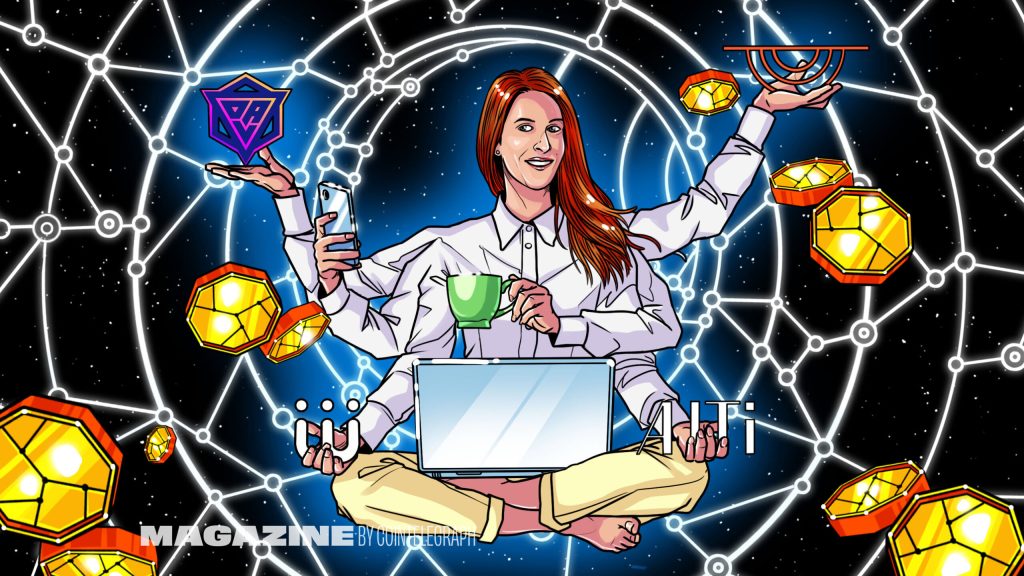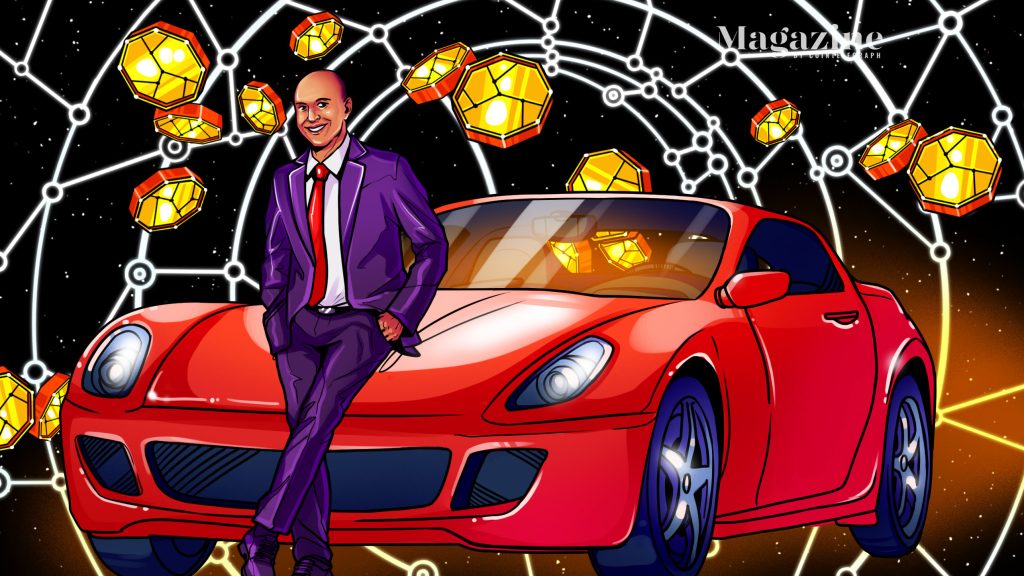Journeys: Hervé Larren on Bitcoin, Apes and the psychology of ‘blue-chip’ NFTs


Hervé Larren’s crypto journey has taken him from luxury goods to Bitcoin mining and back full circle to the world of “blue-chip” NFTs.
During a period of hyperinflation in 2013, my Venezuelan mother asked me to send money to Caracas, the countrys capital, Herv Larren recalls. However, bank transfers were not possible between the two countries.
Busy with work in New York, he told a friend that he planned to fly to Caracas carrying cash for his mother and return the same day. Why dont you just send Bitcoin? his friend asked, which quickly led to a change of plans as Larren made his first Bitcoin transfer.
My first crypto transaction, in 2013, was to wire Bitcoin from the U.S. to Venezuela. Due to the economic collapse, there was no functioning banking system between these two countries.
Switching from a career with luxury goods company LVMH Mot Hennessy Louis Vuitton, Larren co-founded a large-scale crypto mining operation and worked with Grayscale to bring crypto assets to old-school investors. He later became a key adviser to ApeCoin and the first person to bid a million dollars for a nonfungible token.
From old to new
We were reporting to Nicolas Sarkozy, and he was coming to our meetings, Larren recalls of his time as the head of a high school student council in Neuilly-sur-Seine, the wealthiest old-money suburb of Paris, where he grew up.
Sarkozy served as the local mayor for 20 years before becoming the president of France. Larrens mother from Venezuela was a TV host and the first Latina model signed by the LOreal cosmetics brand. His French father imported wine to Canada, where a third of the population is French-speaking.
In the late 90s, Larren began undergraduate business studies at Montreals Concordia University. In 2019, Concordia labeled him The Blockchain Maven as part of a 50 Under 50 alumni distinction. Upon graduation, he got a job at Mot Hennessys New York office, where he worked on brand development of the firms Hennessy cognac brand in the United States.
Larren worked on his MBA at Columbia University part time while at LVMH, graduating in 2010 and entering the venture capital world with Peak Ventures, which was involved in tech companies including Twitter. It was Larrens first experience in the technology sector, which he describes as very different from the old-world, intergenerational luxury goods industry.
Larren quickly moved to accept Bitcoin at an e-commerce business he was involved with, a company that helped charities raise money by partnering with celebrities. In 2015, he formed crypto mining firm Global Crypto Ventures, which grew into an operation of nearly 3,000 machines composed primarily of Bitmain Antminer S9 miners in Las Vegas and Texas, where the cost of infrastructure and electricity was cheaper.


Grayscale Digital Large Cap Fund
While speaking at the 2017 World Technology Forum in New York, Larren met Digital Currency Group CEO Barry Silbert, who was talking right after him about the Grayscale Bitcoin Trust, through which retail investors could get exposure to Bitcoin through their brokerage. He was also working on a new investment vehicle called Grayscale Digital Large Cap Fund (GDLC), which represented a weighted portfolio of cryptocurrencies, including Ether, MATIC, ADA and SOL, in addition to Bitcoin.
As a publicly traded investment instrument, it would require approval by the Securities and Exchange Commission. One relevant matter would be to ensure that the fund could buy its digital assets from a trusted source, preferably from within the United States. Larrens mining firm was an ideal source, and having a ready buyer for mining proceeds made business smoother.
This opportunity represented Larrens first foray into crypto beyond Bitcoin, and it attracted me to a new space.
Working with the SEC was no easy task, Larren recalls. It was a nerve-racking process. Though the company was very confident about getting approval, there was a lot of uncertainty because no such investment trust had been approved previously.
However, the GDLC was approved, expanding the potential pool of crypto investors. Though many in the industry continue to preach the not your keys, not your coins mantra, Larren argues that just as with stocks, owning Bitcoin and other crypto assets through a financial instrument instead of on an exchange or cold-storage device is preferable for most of the public.
There is less risk of being hacked or losing access to keys, and regulated funds must meet stringent security policies and often carry insurance. He also notes that they are easier to manage on a portfolio basis, particularly regarding taxation and being more straightforward for accountants to understand.
Will BlackRocks Bitcoin ETF be approved?
These advantages make it easy to see why heavyweights of the financial industry see an opportunity in offering Bitcoin investment vehicles accessible to retail investors. One of these is BlackRock, which recently applied to launch a Bitcoin spot exchange-traded fund in the United States.
BlackRock offers the credibility to convince the SEC that the Bitcoin market can be operated safely and has much to offer investors, Larren says optimistically. He expects that with BlackRocks track record of 575 approved ETFs versus one denial, it will soon come online, with similar products expected in other markets.
I think it would lead to an automatic rise in Bitcoins price. I think many people are on the sidelines waiting for clarity, and thats a step in Bitcoins institutional adoption.
For a very long time, Grayscale had a premium on its shares compared with the price of Bitcoin, Larren notes, explaining that the security, certainty and convenience meant that more conservative investors were historically willing to pay more per BTC. BlackRocks ETF is unlikely to hold a large premium, which would serve to make the market more efficient.
All roads in Decentraland lead to Beeple
Larren first heard about the metaverse through Decentralands initial coin offering in August 2017. They were selling 90,000 pieces of NFT land in the metaverse, he recalls, adding that he felt a proximity to the projects Argentine founders due to South Americas shared currency issues. My first NFT purchase was actually buying my name in the metaverse, he says, recalling how he spent 100 MANA to name his avatar.
He was also given a piece of land on which to build the Airvey art gallery, where Larren placed various NFTs for sale. When Christies announced it would auction Beeples Everydays piece in its first-ever NFT auction in March 2021 a story previously covered by Magazine the auction house contacted the Airvey gallery to invite bids.
I wanted to be the first person in the world who bid seven figures on an NFT.
Well that escalated quickly was Beeples only comment when Larrens bid for $1 million came through, representing the first volley in a bidding battle that would see an anonymous buyer later revealed as Vignesh Sundaresan, also known as Metakovan, beat Tron founder Justin Sun with a record-setting bid of $69 million.


Bored Apes design ApeCoin
With a newfound passion for NFTs, Larren joined Horizen Labs in 2021, months before the firm began discussions with Yuga Labs, a small company where four founders were working on an NFT project involving monkeys.
Yuga contracted Horizen Labs to create ApeCoin, a large allocation of which was distributed to holders of Yugas NFT collections including Bored Ape Yacht Club, Mutant Ape Yacht Club and Bored Ape Kennel Club via massive airdrop.
We did everything from the white paper, tokenomics, to listing on exchanges. In less than 20 minutes, it became an $8 billion project, Larren says, referring to the tokens undiluted market cap, now about $2 billion. In addition to the launch, Larren notes that Horizen Labs designed the tokens staking mechanism, which will see 100 million tokens distributed to the community over three years.
As Gucci and TAG Heuer began accepting ApeCoin as a form of payment, Larrens luxury contacts came calling back.
I spent a week with Chanels team at a castle in the English countryside, educating them on all aspects of Web3, including MetaMask and NFT drops. Larren observes that as he moved from the most successful physical goods company, LVMH, to the most successful digital goods company, Yuga Labs, the thought process was the same.
He describes metaverse real estate and PFPs, which include Yugas famous monkey pictures, as fitting into a broad category of consumer NFTs that are purchased by individuals in a way not dissimilar to luxury goods. Indeed, he notes that many of LVMH founder Bernard Arnaults children heirs of the worlds second-richest man are actively dabbling in them.


People want to feel that they are part of an exclusive community with like-minded individuals, he explains, relating the concept sold in luxury boutiques and exclusive events the world over. In the case of Yugas NFTs, he argues that there is value for many people in being members of a group that shares similar cultural references, whether it being digital or at concerts, referring to events like ApeFest, the next of which will take place in Hong Kong in November.
Can an ape JPG really be a blue-chip NFT?
NFTs that gain mass appeal as recognizable status symbols are often labeled as blue chip among the NFT community, a nod to a term typically referring to reliable stocks and originally derived from poker, where blue chips are traditionally the most valuable.
Its a brand-building element as recognition of industry and buyers. Supply is far less than demand, and there is a strong fan and collector base. In traditional art, Picasso and Jean-Michel Basquiat are blue chips, he explains, noting that Bored Apes and CryptoPunks hold such a position within the PFP hierarchy.
The price is a result of the value that has been created. When you go to a Louis Vuitton store, the price is nowhere to be seen.
Holding a BAYC can make sense because you can stake it to earn tokens, and it can act as a financial instrument because you can borrow against it, he notes, naturally enough, considering his company designed the staking mechanism.


There are blue chips in other categories as well, such as metaverse land, he adds, cautioning that its value, like traditional real estate, will depend on the income generated with it.
This is because, in his opinion, people will not remain interested in vast spaces of empty metaverse land but rather in spaces that are built up and useful, like his art gallery. Traditional real estate involves buildings the same will be true of metaverse land.
Where might we look for the next crop of blue chips?
Im now passionate about building on top of Bitcoin with BRC-20s and Ordinals, Larren explains, hinting that something big is in the works. For him, the coming metaverse is a place and time when your digital life is more important than your physical life and where digital image matters more than physical image. In this new environment, he believes that the Bitcoin chain, with its newfound capability to host NFTs, will hold a key position as a central pillar.
In Web3, you need to anticipate how consumer taste will evolve and what the market will want in the next six months.




























































